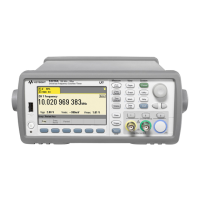140 53220A/53230A User’s Guide
4 53220A/53230A Input Signal Conditioning
Input Slope Example
//set the threshold slope
CONF:FREQ 1E6, 0.1, (@1) // measure 1 MHz signal
SYST:ALEV:FREQ 10E3 // set minimum auto-level frequency
INP:IMP 50 // set impedance to 50 ohms
INP:RANG 5 // set range to 5V
INP:COUP AC // set AC coupling
INP:LEV:REL 70 // 70% threshold level
INP:SLOP POS // trigger on positive slope
Measuring Input Signal Levels and Signal Strength
Minimum, maximum, and peak-to-peak levels of the input signal are indicated
on the bottom of the counter’s main measurement display area and an exam-
ple is included in Figure 4-4. These characteristics of the peak-to-peak signal
can also be measured with the commands:
INPut[{1|2}]:LEVel:MINimum? (minimum value of p-p signal)
INPut[{1|2}]:LEVel:MAXimum? (maximum value of p-p signal)
INPut[{1|2}]:LEVel:PTPeak? (p-p amplitude)
The minimum and maximum values include any DC levels (offsets) present
with the signals. The counter’s input impedance also affects the amplitude at
the input.
Channel 3 Signal Strength

